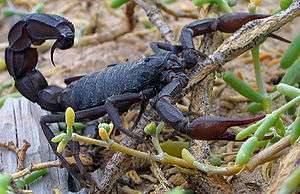Fattail scorpion
| Fattail scorpions | |
|---|---|
 | |
| Arabian fat-tailed scorpion, Androctonus crassicauda. | |
| Scientific classification | |
| Kingdom: | Animalia |
| Phylum: | Arthropoda |
| Subphylum: | Chelicerata |
| Class: | Arachnida |
| Order: | Scorpiones |
| Family: | Buthidae |
| Genus: | Androctonus Ehrenberg, 1828 |
| Diversity | |
| About 18 species | |
Fattail Scorpion or fat-tailed scorpion is the common name given to scorpions of the genus Androctonus, one of the most dangerous groups of scorpions species in the world.[1] They are found throughout the semi-arid and arid regions of the Middle East and Africa.[1] They are a moderate sized scorpion, attaining lengths of 10 cm (just under 4 in).[2] Their common name is derived from their distinctly fat metasoma, or tail, while the Latin name originates from Greek and means "man killer".[2] Their venom contains powerful neurotoxins and is especially potent.[1] Stings from Androctonus species are known to cause several human deaths each year.[1] Several pharmaceutical companies manufacture an antivenom for treatment of Androctonus envenomations.[3]
Geographic range
Androctonus is widespread in North and West Africa, the Middle East and eastwards to the Hindukush region. Countries where Androctonus species live include: Armenia, Morocco, Algeria, Tunisia, Libya, Egypt, Togo, Palestine, Israel, India, Lebanon, Turkey, Jordan, Saudi Arabia, Yemen, Oman, United Arab Emirates, Qatar, Kuwait, Iraq, Iran, Afghanistan, Bahrain and Pakistan.
Etymology
A rough English translation of the name Androctonus is "man-killer", from the Greek andras (άνδρας), meaning "man" and kteinein (κτείνειν), meaning "to kill". Crassicauda means fat-tailed, from the Latin crassus meaning "thick" or "fat" and cauda, meaning "tail". Androctonus crassicauda is widespread throughout the Middle East and its name means "fat-tailed man-killer". Similarly, the Latin word for South is australis, from which Androctonus australis, "southern man-killer", derives.
Taxonomy

Taxonomic reclassification is ongoing, sources tend to disagree on the number of species.
- Androctonus afghanus Lourenço & Qi, 2006
- Androctonus aleksandrplotkini Lourenço & Qi, 2007
- Androctonus amoreuxi (Audouin, 1826)
- Androctonus australis (Linnaeus, 1758)
- Androctonus baluchicus (Pocock, 1900)
- Androctonus bicolor Ehrenberg, 1828
- Androctonus crassicauda (Olivier, 1807)
- Androctonus dekeyseri Lourenço, 2005
- Androctonus eburneus (Pallary, 1928)
- Androctonus finitimus (Pocock, 1897)
- Androctonus gonneti Vachon, 1948
- Androctonus hoggarensis (Pallary, 1929)
- Androctonus liouvillei (Pallary, 1924)
- Androctonus maelfaiti Lourenço, 2005
- Androctonus mauritanicus (Pocock, 1902)
- Androctonus maroccanus Lourenço, Ythier & Leguin, 2009
- Androctonus sergenti (Vachon, 1948)
- Androctonus togolensis Lourenço, 2008
In captivity
Scorpions such as these are very dangerous, and despite the risks of keeping such a dangerously venomous species in captivity, Androctonus scorpions are frequently found in the exotic animal trade - A. amoreuxi and A. australis being the most commonly available. As with any dangerous scorpion, a potential Androctonus-keeper should think very carefully before acquiring one because a sting may have serious consequences which extend beyond the immediate risks of injury or death. For example, there can be an expensive bill for emergency medical care that the owner's health insurance may not entirely cover. There is also potential legal liability if someone other than the owner is stung. Depending on the jurisdiction in which the keeper lives, some form of license or insurance policy may be required in order to possess a dangerous scorpion. In some jurisdictions, possession of a dangerous scorpion is illegal. Extra precautions must be taken to ensure that the scorpion cannot escape. Scorpions will generally try to kill and eat anything which moves and is smaller than themselves. In order to simulate the desert environment, the enclosure used to keep the scorpion in must be kept at a temperature of between 26 and 30 degrees Celsius (78.8 degrees and 86 degrees Fahrenheit).
References
- 1 2 3 4 Hendrixson, B. E. 2006. Buthid scorpions of Saudi Arabia, with notes on other families (Scorpiones: Buthidae, Liochelidae, Scorpionidae). In W. Büttiker, F. Krupp, I. Nader & W. Schneider (eds.), Fauna of Arabia (pp. in press, ~100 pages). Basel, Switzerland: Karger Libri.
- 1 2 "Windaroo Zoo : Scorpion".
- ↑ "Antidotes In Depth, Jeffrey N. Bernstein" (PDF).
External links
- The Scorpion Files: Buthidae
- Photo of Androctonus habitat in Kuwait
- Treatment of Androctonus stings at eMedicine
- Treatment of Androctonus stings